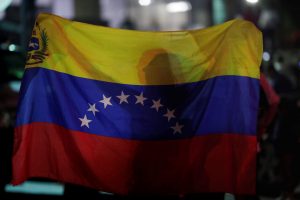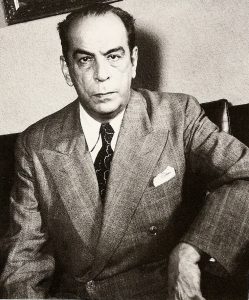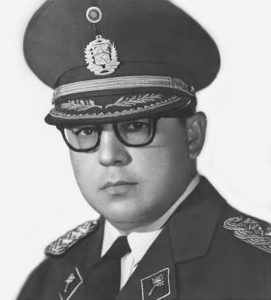Italians In Venezuela
By: Maya Harvey
While Italian immigration to Latin American countries is a well studied subject, their specific arrival into the Venezuelan community is less documented. This however, doesn’t attest to the italian influences that can still be recognized today.

A woman holds a Venezuelan flag while participating in a candlelight vigil held for victims of recent violence in Caracas, Venezuela May 5, 2019. REUTERS/Ueslei Marcelino
There are three major waves of the Italian diaspora, the first occurring shortly after unification of Italy between 1861 and 1900 (The Italian Diaspora) . This wave was mainly due to the impoverished state of the new nation, along with a lack of available property (The Italian Diaspora). The emigration was especially prominent in the southern regions of Italy, where the unification process sparked a socio-economic boom, which then caused overpopulation in these areas (The Italian Diaspora). Life in these regions had little to offer, “… the soil was poor, yielding little, while malnutrition and disease were widespread.” and especially younger generations felt they had no choice but to leave their country of birth (The Public Broadcasting Service).
The second wave occurred at the beginning of world war 1 and ended in the 1970s, and included more than 9 million Italians (The Italian Diaspora). This wave consisted of many southern Italians who traveled to North or South America (The Italian Diaspora).
The third wave which occurs after world war two is most relevant to Venezuela, as their political administration put forth policies to specifically attract immigrant workers (D’Angelo, Emigranti e imprenditori). The Italians who came to Venezuela, especially with the initiation of their “open door” immigration policy, were based in more urban areas, working in more industrial sectors (D’Angelo, Emigranti e imprenditori). Most Italian immigrants elsewhere in South America found success in the agriculture sector, establishing and growing more culturally dense communities, but this occurred on a much more limited scale in Venezuela (D’Angelo, Emigranti e imprenditori). My blog looks to not only understand Italian Immigrants’ place in the economy, but to investigate how particular factors of the country affected their stance.
A Diverse Geographic Landscape
Venezuela is famous for its physiographic diversity. At a total area of 912,050 square kilometers, the country is about double the size of California (Haggerty). The 2,800-kilometer coast touches both the Caribbean Sea and Atlantic Ocean, and the country is physically bordered by Guyama, Brazil, and Colombia (Haggerty). Within national borders are four main regions; the Maracaibo lowlands of the northeast, the northern Andean mountain chains, the Orinoco plains of central Venezuela, and Guiana highlands in the southeast (Haggerty).

Angel Falls, Venezuela
The climate of Venezuela ranges from “tropical humid to alpine” depending on the actual elevation of the area (Haggerty). Seasons are distinguished more frequently by the rainfall more than the temperature due to the entire country being located in the tropics (Haggerty). The rain levels vary greatly, ranging from about “…430 millimeters in the western…”, semiarid, caribbean coast, to around “.. 1,000 millimeters in the Orinoco Delta…” area (Haggerty). However Venezuela “… falls into four horizontal temperature zones based primarily on elevation” (Haggerty). Below 800 meters is considered the tropical zone, with hot temperatures averaging 26° C and 28° C (Haggerty). Between 800 and 2,000 meters is a milder climate ranging from around 12° C to 25° C (this is the climate in which most cities are located) and between 2,000 and 3,000 meters is considered the cool zone, from 9° C to 11° C (Haggerty). Above 3,000 feet, known as the páramos maintains a permanent snowy landscape and is typically below 8° C (Haggerty).

Geographical Map of Venezuela
In terms of climate, it makes sense to see most Italian immigrants locating to the warm-mild regions of Venezuela, being that most had traveled from the hot, humid southern regions of Italy. These regions also included most major cities, which included more industrious opportunities compared to the more desolate, colder regions of Venezuela (Haggerty).
Post World War Two: Open Door Policy
After World World II, Europe’s socioeconomic situation aided in creating a broader supply of working opportunities in Venezuela (Grau). This was also due to Romulo Gallegos, the first cleanly elected president, who took office briefly between 1947-1948 (D’Angelo, Emigranti e imprenditori). President Gallegos initiated the implementation of an “open-door” policy, which sparked an influx of Italians, eventually becoming the largest European population group within Venezuela (D’Angelo, Emigranti e imprenditori). The policy remained in place to differentiating degrees until 1958, under the dictatorship of General Marcos Perez Jimenez (D’Angelo, Emigranti e imprenditori). According to the National Census of Venezuela, the Italian population spiked from 3,137 in 1941 to 43,997 within the nine years that followed. This number continues to increase through 1961 when the population hits a high of 121,733 (D’Angelo, Emigranti e imprenditori). By 1976, In part, the rise of immigration was due to the state of post war Italy, “La ricchezza del Venezuela si coniuga per contrasto con le condizioni disastrose dell’italia all’indomani della guerra” (D’Angelo, Emigranti e imprenditori).

Rómulo Gallegos
Unlike in their home country, these Italians found economic conditions that benefited their livelihood. The desire to later return to Italy encouraged the immigrants to work hard, but a result of this new economic environment provided them the ability to also improve their financial situations to a greater, and more rapid degree (D’Angelo, Emigranti e imprenditori). The immigrants were willing to make drastic sacrifices and lifestyle changes in order to achieve the dignity and pride that comes with finally achieving land ownership (D’Angelo). This included”… lavorano anche sedici ore al giorno; riducono al minimo le spese, accettando ogni possibile rinuncia, pur di riuscire a risparmiare il più possibile; si adattano a vivere nei retrobottega, o in capanne di lamiera, o in tanti in un’unica stanza presa in affitto”(D’Angelo, Una emigrazione di prima generazione in America Latina). Italian’s work ethic also instilled tensions towards the local workers, “… causa di pregiudizi nei confronti dei venezuelani – ritenuti indolenti e pigri…” (D’Angelo, Emigranti e imprenditori). The caribbean culture is more relaxed in nature, a consequence of the tropical landscapes (D’Angelo, Una emigrazione di prima generazione in America Latina). An innate contrast to the fast paced Italian culture, even compared to the southern regions. Therefore, the cultural contrast in work culture helped create these negative connotations towards the Venezuelans.
Work opportunities were facilitated by the government as well; Italian immigrants, along with the Spanish & Portuguese were pushed to contribute “especially to the needs of the construction sector, the iron, and steel industry, petrochemicals, hydro-electricity and dams” (Grau).
Specifically, Venezuela needed tradesmen, which made Italian immigrants a prime candidate. The typical Italian immigrant arrived with knowledge of a trade, artisans with a particular skill set, built from a very young age (D’Angelo,Una emigrazione di prima generazione in America Latina). In fact, the nickname for Italians in Venezuela is “zapatero”, meaning shoe maker (D’Angelo, Una emigrazione di prima generazione in America Latina). Above all, most Italian immigrants were knowledgeable in bricklaying, which made them valuable for the construction sector (D’Angelo, Emigranti e imprenditori).
From these trends one can see how Italians acted as an important puzzle piece, filling a much needed gap within the Venezuelan economy. Their skill sets were already valuable within Venezuela, and with their incredible work ethic, most italians were able to become successful entrepreneurs in short periods of time.This is a factor of influence which explains italians ties to the more industrialized working sectors.
From Coffee to Oil; Agriculture to Industry
A huge shift to the Venezuelan economy came with the country’s massive exploitation of oil, beginning in the 1920s (D’Angelo, Emigranti e imprenditori). This affected Italian immigration in two ways, first by acting as a financial resource by aiding the economy, as a result, causing the country to look attractive to potential immigrants. Secondly, as Venezuela became reliant on it’s oil exports, it’s economy became destabilized, eventually causing massive financial problems. This is exactly the case of the 1973 oil crisis, which shook the Venezulan economy (D’Angelo, Emigranti e imprenditori).
Before exploring these specific industries, one should first be aware of three elements that play into the Venezuelan economy. Firstly is “la struttura della proprietà della terra è basata sul latifondo … dualismo funzionale” (D’Angelo, Emigranti e imprenditori). This process allows low cost foods into the urban sectors, where low wages can be sustained. Secondly is to understand that “… la colonizzazione del Venezuela e l’inserimento della popolazione immigrata risentono della natura del territorio federale…” (D’Angelo, Emigranti e imprenditori). Lastly is that “il processo di industrializzazione del paese si avvia convintamente solo dopo la seconda guerra mondiale”(D’Angelo, Emigranti e imprenditori).
Knowing these factors, one can see how large economic movements, such as the shift from coffee/agriculture sector to oil/industry could affect their financial sector. Oil is about 95% of Venezuela’s exports as well as 25% of its GDP as of 2019 (DePersio). For countries that import more oil than it sells, low prices are welcomed, but for opposite functioning countries like Venezuela, a drop in the price of oil can be devastating (DePersio). Even worse, since the country’s economic stance is intrinsic with oil prices, frequent changes are likely (DePersio). Combine this with decreases in oil output, a shrinking economy, debt accumulation, hyperinflation and it’s simple to see how major problems arose for the nation (Council on Foreign Relations).
The Fall of General Marcos Perez Jimenez
The Electoral Law of 1957, which allotted to foreigners voting rights for the very first time, became a detrimental event for the Italian communities in Venezuela (D’Angelo, Emigranti e imprenditori). The law was put into place by General Marcos Pérez Jiménez, to aid him in his reelection campaign (D’Angelo, Emigranti e imprenditori). The Italians had flourished under his administration because he had started many urban infrastructure projects (D’Angelo, Emigranti e imprenditori). There were ample opportunities to work in construction developments, and as a result the economic stance increased within its cities, especially Caracas (D’Angelo, Emigranti e imprenditori). The loss of Jimenez meant that his social programs would end, and a huge gap in leadership would follow (D’Angelo, Emigranti e imprenditori).
The Italian immigrants had notably supported President Jimenez’s referendum, as well as expressing “public adherence to the dictatorship by about 75,000 Italians, led by Italian businessman Filippo Gagliardi” (Grau). Filippo Gagliardi came from modestly in Montesano sulla Marcellana, and first traveled to Venezuela to stay with a relative at 15 years old(Citro). A family argument caused him to return home, but ten years later in 1937 he returned to South America where he began working in construction (Citro). He became one of the most prominent, wealthy businessmen in the area, but his legacy is in the major financial donations he made during his life, “…sono oltre 86 le amministrazioni comunali in tutta Italia che rientrano nella lunga lista di donazioni effettuate da Gagliardi”(Citro). He gave money to many impoverished Italian families, “… opere pubbliche volte a migliorare le condizioni di vita di migliaia di persone durante il secondo dopoguerra”(Citro). Filippo was an inspiration, a real life version of the dreams many Italian immigrants hoped to achieve.
And so, when the General fell from power in the early months of 1958, “… … molti italiani furono feriti e persero la casa a Caracas, Maracaibo, Valencia e Barinas ” as a result (D’Angelo, Emigranti e imprenditori). The attitude towards the removed president was also reflected on the groups who were supportive of him (D’Angelo, Emigranti e imprenditori). For this reason, many immigrants and their families chose to return to Italy through the following year, subsiding towards the end of February, when the Secretary of Foriegn Affairs recognized the potential damage of this shift and proceeded to guarantee security to the remaining Italians in Venezuela (D’Angelo, Emigranti e imprenditori). Even so, “… il flusso di emigrazione lavorativa inizia, a poco, a poco, a essere sostituita da chi arriva, davvero per visitare i parenti o per ammirare le bellezze della natura” (D’Angelo, Emigranti e imprenditori). This is a relevant factor, since acts of disdain towards the Italian populace undoubtedly affected the decisions of that ethnic group in regards to choosing to leave or enter the country.
